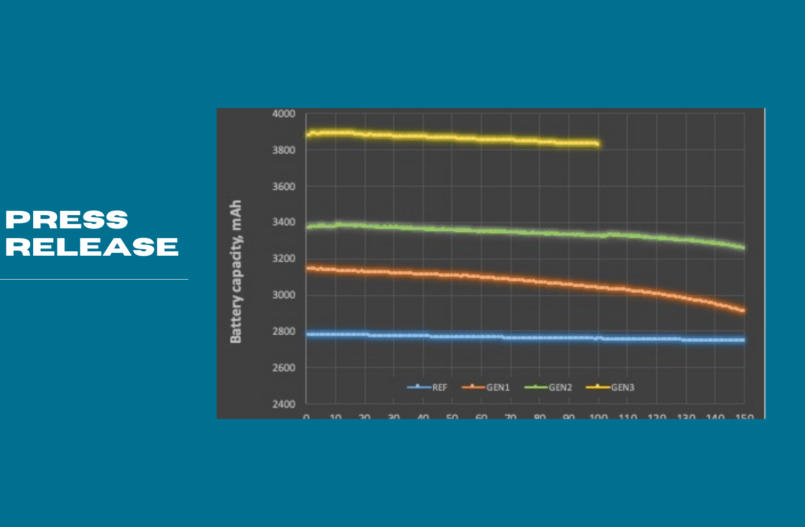- After 100 cycles, 18650 batteries with GEN3 silicon-based materials still outperform commercially available graphite batteries by approximately 40%, GEN1 by over 26%, and GEN2 by over 15%, all with minimal noticeable degradation [1].
MONTREAL, Canada — HPQ Silicon Inc. (“HPQ” or the “Company”) (TSX-V: HPQ) (OTCQB: HPQFF) (FRA: O08), a technology company specializing in green engineering of silica and silicon-based materials, is pleased to update shareholders on new battery milestones achieved by its France-based affiliate, NOVACIUM SAS (“Novacium”).
This update highlights the positive trend observed after 100 charge-discharge cycles in the latest tests of Lithium-ion 18650 batteries, made with a blend of graphite and Novacium’s GEN3 silicon-based anode material. The charge-discharge tests [2], which simulate real-world usage to assess durability and longevity, confirm a 40% overall capacity improvement compared to the graphite benchmark.
Additionally, after 100 cycles, the battery performance is 26% higher than the previous GEN1 material and 15% higher than the GEN2 material, with minimal degradation compared to the graphite benchmark, at less than 0.5%.
“These results confirm our position as a top-tier producer of advanced silicon anode material,” said Dr. Jed Kraiem, COO of Novacium. “The ability to producing silicon-based anode material that enables 18650 battery cells to exceed 4,000 mAh under maximum discharge testing conditions, as highlighted in the July 30th, 2024, release, and achieve 40% more capacity than graphite-only Li-Ion batteries after 100 charge-discharge cycles under real-world conditions demonstrate our capabilities and expertise in the domain.”
ENHANCING BATTERY PERFORMANCE WITH SILICON-BASED ANODE MATERIALS
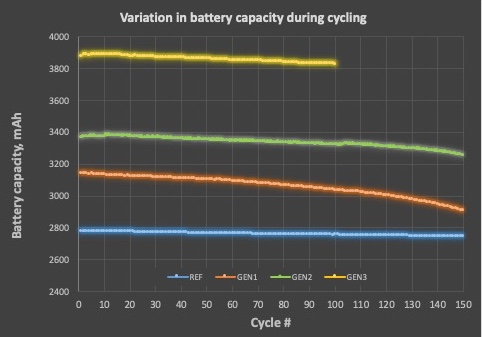
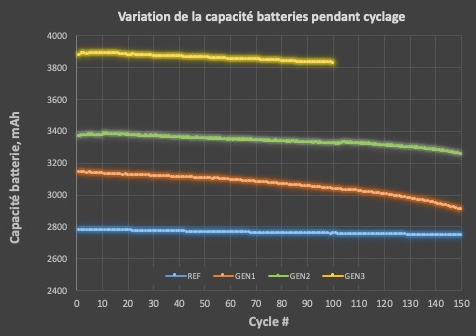
Graph 1 illustrates the battery capacity, in mAh, of batteries made with Novacium GEN3 materials over the first 100 cycles, (yellow line) compared to those made with GEN2 and GEN1 materials, as well as 100% graphite benchmark batteries (green, orange and blue lines) over 150 cycles.
Using the data from Graph 1, we observe that at 100 cycles, the average capacity of three 18650 batteries made with Novacium GEN3 materials remains at a very respectable 3,838 mAh. In comparison, the average capacities are 3,332 mAh for three batteries made with Novacium GEN2 materials, 3,040 mAh for three batteries made with GEN1 materials, and 2,758 mAh for three 100% graphite benchmark batteries.
Therefore, after 100 cycles, GEN3 silicon-based batteries continues to demonstrate an overall capacity improvement of approximately 40% compared to the graphite benchmark, 26% compared to GEN1 material, and 15% compared to GEN2 material.
SILICON-BASED ANODE MATERIALS WITH GRAPHITE-LIKE DEGRADATION AT 100 CYCLES
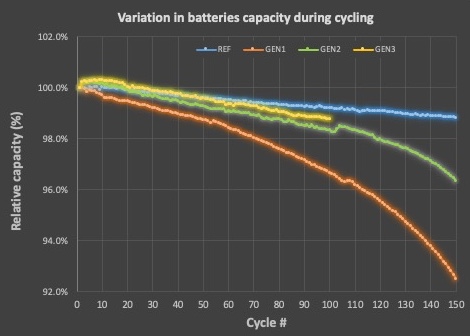
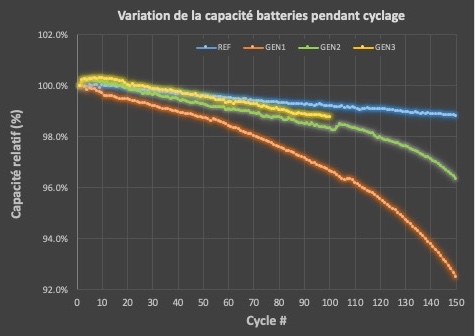
montre la capacité relative des batteries GEN2, sur 150 cycles [1], alors que la ligne jaune montre la capacité relative des batteries GEN3 sur 50 cycles [1].
Graph 2 shows that the performance degradation for GEN3 advanced silicon material over 100 cycles is minimal, with a retention of 98.8% compared to 99.2% for the graphite benchmark. This difference of less than 0.5% is very minimal and falls within the margin of error.
Using the results from the 100-cycle tests shown in Graph 2, we observe that the relative capacity of 18650 batteries made with Novacium GEN3 materials (yellow line) is 98.8%, decreasing from 3,883.0 mAh to 3,838.2 mAh. In comparison, the relative capacity of the batteries made with Novacium GEN2 materials (green line) is 98.3%, decreasing from 3,370.1 mAh to 3,332.4 mAh, while the relative capacity of those made with GEN1 materials (orange line) is 97.7%, decreasing from 3,145.5 mAh to 3,040.2 mAh.
Finally, the relative capacity of the 18650 batteries made with 100% graphite (blue line) is 99.2%, decreasing from 2,780.0 mAh to 2,758.5 mAh.
“Our material integrates seamlessly into existing manufacturing processes, allowing manufacturers to adopt these cutting-edge batteries anode materials without the need for costly retooling or overhauls,” said Bernard Tourillon, President and CEO of HPQ Silicon Inc. and NOVACIUM SAS. “These advancements not only streamline production but also accelerate the widespread adoption of high-performance silicon-based batteries, setting a new standard in the industry.”
REFERENCE SOURCES
[1] Novacium technical team analysis of the data from the ongoing charging and discharging cycle tests conducted at a world-leading university, the name of which is kept confidential for competitive reasons.
[2] Cycling parameters from: Ratnakumar Bugga et al. “Performance of Commercial High Energy and High Power Li-Ion Cells in Jovian Missions Encountering High Radiation Environments”, NASA Battery Workshop November 19-21, 2019.
About NOVACIUM SAS
Novacium is an HPQ – affiliated company that started in Q3 2022. This green technology startup is based in Lyon, France and is a partnership with HPQ and three of France’s leading research engineers, Dr. Jed KRAIEM PhD, Novacium’s Chief Operating Officer (“COO”), Dr. Oleksiy NICHIPORUK PhD, Novacium’s Chief Technical Officer (“CTO”), and Dr. Julien DEGOULANGE PhD, Novacium’s Chief Innovation Officer (“CIO”). Novacium is a new Research and Development company which allows researchers to develop their own technology in high-added-value fields connected to renewable energy and allows HPQ Silicon Inc. a Canadian company, to expand the depth and reach of its technical team to help develop its silicon and new renewable energy projects.

